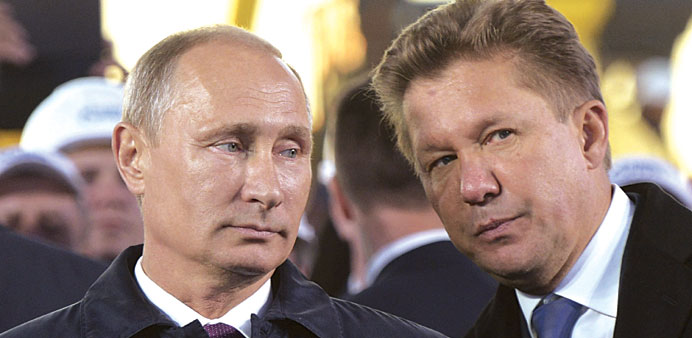Russia’s President Vladimir Putin (left) listens to Gazprom CEO Alexei Miller during a ceremony marking the start of construction of the ‘Power of Siberia’ pipeline at the village of Us Khatyn yesterday.
Reuters/Us Khatyn, Russia
President Vladimir Putin yesterday oversaw the start of construction on a giant pipeline that is due to ship $400bn worth of Russian gas to China in the three decades after flows begin in 2019.
The 4,000 km (2,500 mile) “Power of Siberia” pipeline, being built by state-controlled Gazprom, forms a key part of the Kremlin’s energy strategy, symbolising Russia’s attempts to wean itself off dependence on European markets that account for most of its exports.
“Just now, we along with our Chinese friends are starting the biggest construction project in the world,” Putin told a Chinese delegation, headed by Vice Premier Zhang Gaoli, and a group of Gazprom workers in Russia’s far east.
He said the first gas pipeline between Russia and China: “Will not only allow us to export gas, but to develop gas infrastructure in our country, to speed up (economic) development, not only in this region, but in the whole country.”
Putin also told Zhang that he welcomed the idea of Chinese investors joining the Vankor oil project in east Siberia, owned by Russia’s Rosneft.
Flows through the “Power of Siberia” will start at 5bn cubic metres (bcm) of gas in 2019, ramping up to 38 bcm under a deal signed by the two countries in May.
The long-awaited deal with China National Petroleum Corp (CNPC) was a diplomatic coup for the Kremlin after a decade of difficult negotiations, and a symbol of its efforts to strengthen economic ties with Asia as Russia’s economy faces the effects of Western sanctions over the crisis in Ukraine.
Gazprom chief Alexei Miller told Putin and Zhang that a further contract on shipment of gas via a second, more westerly route, could be signed in November: “If we work closely with CNPC.” He did not give details,
however.
On Putin’s command “Begin!” two workers lowered their protective visors and welded the first segment of the black pipeline with flaring blowtorches. The Kremlin leader then signed his name on it.
With a total capacity of 61 bcm per year, the new pipeline should deliver gas both to China and to remote regions in Russia’s Far East. Gazprom said on Saturday it planned to launch its far eastern Chayanda gas field at the end of 2018, aiming to ship the first gas to China in 2019. Chayanda is one of the keys to supplying China and will produce up to 25 bcm a year at its peak.
Gazprom is one of a handful of major Russian state companies not directly affected by Western sanctions. It accounts for around a third of Europe’s gas needs, shipping 161.5 bcm to the region last year.
The company is at the centre of a separate row with Ukraine – a transit country for Russian gas – over gas prices. The disagreement is threatening stable gas supplies to Europe this winter, forcing Europe to step up its search for alternatives to Russian energy supplies.
Apart from Chayanda, Gazprom plans to link another huge Siberian deposit, Kovykta, with the planned pipeline. This would extend the country’s gas pipeline system from west to east, enabling Russia to switch volumes depending on needs. “After we create a gas pipeline network here, in the Far East (and) Siberia, we’ll have the ability to join the European part of the gas pipeline system with the eastern,” Putin was quoted as saying by Interfax.
“It will give big opportunities to send (gas) flows depending on the situation on the global markets.”
A Gazprom official told reporters that at this stage the company would not connect Kovykta to the system. It planned to start pipeline construction from Kovykta in 2019. Excluding Kovykta, the pipeline’s construction along with developing Chayanda would cost around 770bn roubles ($21bn), said Anatoly Titov, head of the Gazprom Transgaz Tomsk unit.
Russia plans to invest $55bn in exploration and pipeline construction to China’s border, while China’s CNPC has said it will build the Chinese section of the pipeline.

